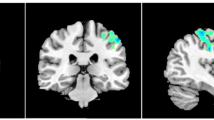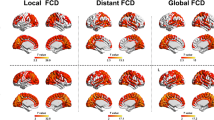Abstract
Objective
To investigate the modulatory effect of acupuncture treatment on the resting-state functional connectivity of brain regions in migraine without aura (MWoA) patients.
Methods
Twelve MWoA patients were treated with standard acupuncture treatment for 4 weeks. All MWoA patients received resting-state functional magnetic resonance imaging (fMRI) scanning before and after acupuncture treatment. Another 12 normal subjects matched in age and gender were recruited to serve as healthy controls. The changes of restingstate functional connectivity in MWoA patients before and after the acupuncture treatment and those with the healthy controls were compared.
Results
Before acupuncture treatment, the MWoA patients had significantly decreased functional connectivity in certain brain regions within the frontal and temporal lobe when compared with the healthy controls. After acupuncture treatment, brain regions showing decreased functional connectivity revealed significant reduction in MWoA patients compared with before acupuncture treatment.
Conclusions
Acupuncture treatment could increase the functional connectivity of brain regions in the intrinsic decreased brain networks in MWoA patients. The results provided further insights into the interpretation of neural mechanisms of acupuncture treatment for migraine.
Similar content being viewed by others
References
Olesen J, Gustavsson A, Svensson M, Jonsson B. The economic cost of brain disorders in Europe. Eur J Neurol 2012;19:155–162.
Lipton RB, Bigal ME, Diamond M, Freitag F, Reed ML, Stewart WF. Migraine prevalence, disease burden, and the need for preventive therapy. Neurology 2007;68:343–349.
Yu S, Liu R, Zhao G, Yang X, Qiao X, Feng J, et al. The prevalence and burden of primary headaches in China: a population-based door-to-door survey. Headache 2012;52:582–591.
Yu S, Zhang M, Zhou J, Liu R, Wan Q, Li Y. Headache care in China. Headache 2014;54:601–609.
Buse DC, Lipton RB. Global perspectives on the burden of episodic and chronic migraine. Cephalalgia 2013;33:885–890.
Li Y, Zheng H, Witt CM, Roll S, Yu SG, Yan J, et al. Acupuncture for migraine prophylaxis: a randomized controlled trial. CMAJ 2012;184:401–410.
Wang LP, Zhang XZ, Guo J, Liu HL, Zhang Y, Liu CZ, et al. Effi cacy of acupuncture for migraine prophylaxis: a singleblinded, double-dummy, randomized controlled trial. Pain 2011;152:1864–1871.
Diener HC, Kronfeld K, Boewing G, Lungenhausen M, Maier C, Molsberger A, et al. Efficacy of acupuncture for the prophylaxis of migraine: a multicentre randomised controlled clinical trial. Lancet Neurol 2006;5:310–316.
Wu GC. Acupuncture analgesia in migraine. Chin J Integr Med 2009;15:248–250.
Linde K, Allais G, Brinkhaus B, Manheimer E, Vickers A, White AR. Acupuncture for migraine prophylaxis. Cochrane Database Syst Rev 2009;1:CD001218.
Lo MY, Lin JG, Wei OM, Sun WZ. Cerebral hemodynamic responses to acupuncture in migraine patients: a systematic review. J Tradit Complement Med 2013;3:213–220.
Zhao L, Qin W, Liu JX, Fang L, Dong MH, Zhang FW, et al. Two sets of acupoint combination of similar functions engage shared neural representation: a functional magnetic resonance imaging study. Chin J Integr Med 2014;20:184–193.
Bai L, Lao L. Neurobiological foundations of acupuncture: the relevance and future prospect based on neuroimaging evidence. Evid Based Complement Alternat Med 2013;2013:812568.
Huang W, Pach D, Napadow V, Park K, Long X, Neumann J, et al. Characterizing acupuncture stimuli using brain imaging with fMRI—a systematic review and meta-analysis of the literature. PLoS One 2012;7:e32960.
Bai L, Tian J, Zhong C, Xue T, You Y, Liu Z, et al. Acupuncture modulates temporal neural responses in wide brain networks: evidence from fMRI study. Mol Pain 2010;6:73.
Headache Classifi cation Subcommittee of the International Headache Society (IHS). The International Classification of Headache Disorders: 2nd edition. Cephalalgia 2004;24(Suppl 1):9–160.
China Academy of Chinese Medical Sciences. Guideline for clinical practice of acupuncture in the treatment of migraine. Beijing: China Press of Traditional Chinese Medicine;2011:142–162.
Wang JJ, Wu ZC, Hu J, Jiao Y, Yang JH. Compilation characteristics and clinical applications of Guideline for Clinical Practice of Acupuncture in the Treatment of Migraine. Chin Acupunct Moxibust (Chin) 2010;30:325–328.
World Health Organization Western Pacific Region. WHO standard acupuncture point locations in the Western Pacifi c Region. Geneva, Switzerland: WHO Press; 2008.
Aun C, Lam YM, Collett B. Evaluation of the use of visual analogue scale in Chinese patients. Pain 1986;25:215–221.
Buysse DJ, Reynolds CF, Monk TH, Berman SR, Kupfer DJ. The Pittsburgh Sleep Quality Index: a new instrument for psychiatric practice and research. Psychiatry Res 1989;28:193–213.
Tessitore A, Russo A, Giordano A, Conte F, Corbo D, De Stefano M, et al. Disrupted default mode network connectivity in migraine without aura. J Headache Pain 2013;14:89.
Russo A, Tessitore A, Giordano A, Corbo D, Marcuccio L, De Stefano M, et al. Executive resting-state network connectivity in migraine without aura. Cephalalgia 2012;32:1041–1048.
Schwedt TJ, Dodick DW. Advanced neuroimaging of migraine. Lancet Neurol 2009;8:560–568.
Kurth T, Mohamed S, Maillard P, Zhu YC, Chabriat H, Mazoyer B, et al. Headache, migraine, and structural brain lesions and function: population based Epidemiology of Vascular Ageing-MRI study. BMJ 2011;342:c7357.
Amin FM, Asghar MS, Hougaard A, Hansen AE, Larsen VA, de Koning PJ, et al. Magnetic resonance angiography of intracranial and extracranial arteries in patients with spontaneous migraine without aura: a cross-sectional study. Lancet Neurol 2013;12:454–461.
Maleki N, Becerra L, Brawn J, Bigal M, Burstein R, Borsook D. Concurrent functional and structural cortical alterations in migraine. Cephalalgia 2012;32:607–620.
Mainero C, Boshyan J, Hadjikhani N. Altered functional magnetic resonance imaging resting-state connectivity in periaqueductal gray networks in migraine. Ann Neurol 2011;70:838–845.
Descamps B, Vandemaele P, Reyngoudt H, Deblaere K, Leybaert L, Paemeleire K, et al. Absence of haemodynamic refractory effects in patients with migraine without aura: an interictal fMRI study. Cephalalgia 2011;31:1220–1231.
Pierelli F, Iacovelli E, Bracaglia M, Serrao M, Coppola G. Abnormal sensorimotor plasticity in migraine without aura patients. Pain 2013;154:1738–1742.
Jin C, Yuan K, Zhao L, Zhao L, Yu D, von Deneen KM, et al. Structural and functional abnormalities in migraine patients without aura. NMR Biomed 2013;26:58–64.
Yu D, Yuan K, Zhao L, Zhao L, Dong M, Liu P, et al. Regional homogeneity abnormalities in patients with interictal migraine without aura: a resting-state study. NMR Biomed 2012;25:806–812.
Yuan K, Qin W, Liu P, Zhao L, Yu D, Zhao L, et al. Reduced fractional anisotropy of corpus callosum modulates interhemispheric resting state functional connectivity in migraine patients without aura. PLoS One 2012;7:e45476.
Xue T, Yuan K, Zhao L, Yu D, Zhao L, Dong T, et al. Intrinsic brain network abnormalities in migraines without aura revealed in resting-state fMRI. PLoS One 2012;7:e52927.
Yu D, Yuan K, Qin W, Zhao L, Dong M, Liu P, et al. Axonal loss of white matter in migraine without aura: a tract-based spatial statistics study. Cephalalgia 2013;33:34–42.
Zhao L, Liu J, Zhang F, Dong X, Peng Y, Qin W, et al. Effects of long-term acupuncture treatment on resting-state brain activity in migraine patients: a randomized controlled trial on active acupoints and inactive acupoints. PLoS One 2014;9:e99538.
Kong J, Jensen K, Loiotile R, Cheetham A, Wey HY, Tan Y, et al. Functional connectivity of the frontoparietal network predicts cognitive modulation of pain. Pain 2013;154:459–467.
Buckner RL, Andrews-Hanna JR, Schacter DL. The brain's default network: anatomy, function, and relevance to disease. Ann N Y Acad Sci 2008;1124:1–38.
Otti A, Noll-Hussong M. Acupuncture-induced pain relief and the human brain's default mode network—an extended view of central effects of acupuncture analgesia. Forsch Komplementmed 2012;19:197–201.
Liu J, Qin W, Nan J, Li J, Yuan K, Zhao L, et al. Genderrelated differences in the dysfunctional resting networks of migraine suffers. PLoS One 2011;6:e27049.
Maleki N, Linnman C, Brawn J, Burstein R, Becerra L, Borsook D. Her versus his migraine: multiple sex differences in brain function and structure. Brain 2012;135:2546–2559.
Author information
Authors and Affiliations
Corresponding author
Additional information
Supported by the National Natural Science Foundation of China (No. 81473667), Beijing Young Talent Program of Beijing Education Committee (No. YETP0823), and the Research Funds of Beijing University of Chinese Medicine (No. 2013-JYBZZJS-148, 2014-JYBZZ-XS-142)
Rights and permissions
About this article
Cite this article
Zhang, Y., Li, Ks., Liu, Hw. et al. Acupuncture treatment modulates the resting-state functional connectivity of brain regions in migraine patients without aura. Chin. J. Integr. Med. 22, 293–301 (2016). https://doi.org/10.1007/s11655-015-2042-4
Received:
Published:
Issue Date:
DOI: https://doi.org/10.1007/s11655-015-2042-4




